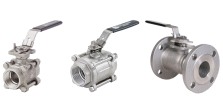https://msjacobs.com
800-348-0089
Sponsored by M.S. Jacobs & Associates, a manufacturer’s representative and distributor of industrial instrumentation, control valves & process controls. Located in Pittsburgh, Pa. and covering Western Pennsylvania, West Virginia, and New York. Representing top lines in pressure, temperature, level, flow, analytical instruments and industrial valves.
Telephone: 800-348-0089 or MSJacobs.com
M.S. Jacobs & Associates, Inc. is happy to announce its appointment as an official ARCA Valves distributor. ARCA Valves has garnered global renown for its innovative technology and established quality since its foundation over a century ago. ARCA's pneumatically and electrically operated control valves provide high value for many industrial applications. They meet the rigors of many challenging applications in various industries, including power plants, chemical plants, pharmaceutical and food processing, and steel mills.
Thanks to its excellent vertical integration, ARCA's manufacturing process is versatile and has a high supply capacity. ARCA manufactures and supplies valves with nominal diameters up to 48" and pressure ratings of over 5,000 PSIG for high-pressure applications.
ARCA's technological leadership is built on 90 years of expertise and ongoing innovation, evidenced by several patents. The factory's output, which is of the highest technical quality and certified to appropriate quality standards, ensures a high level of dependability.
For more information, contact M.S. Jacobs by calling 800-348-0089 or visit https://msjacobs.com.
 |
| Vales utillized in industrial processes can require special materials or finishes. |
 |
| Cashco Control Valve |